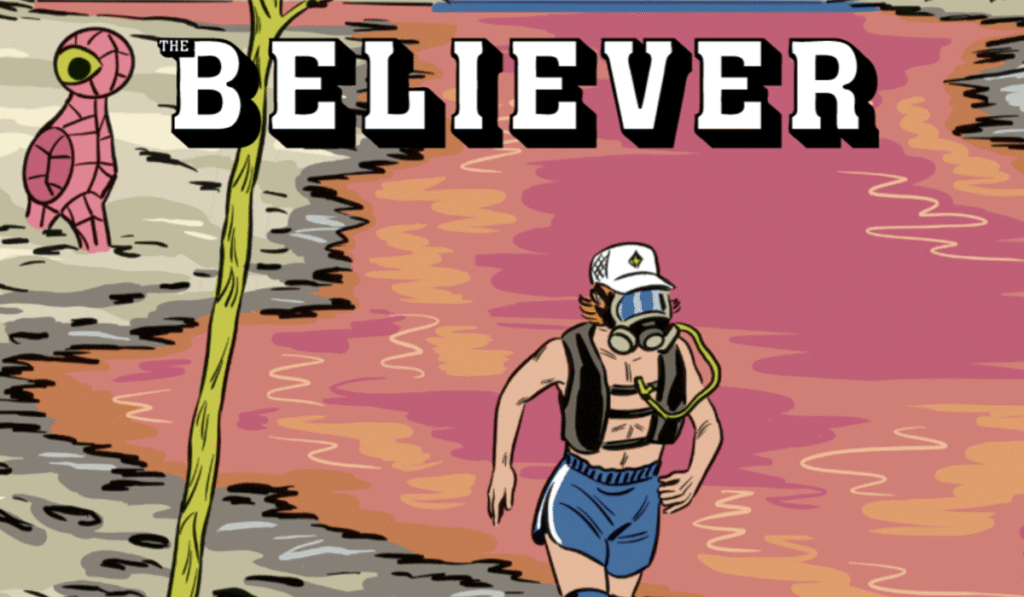At Bombay Beach, a half-ruined former vacation town on the edge of the Salton Sea, absurdist philosophers, artists, and everyday townsfolk have undertaken a postapocalyptic experiment in radical living.
– – –
It is easy to miss California’s biggest environmental disaster. Driving north on Highway 111, you wouldn’t expect to find an inland sea. If it’s summer, the thermometer in your car could read 115 degrees. But amid the shimmering heat, there are signs of water. All around you, rows of broccoli, lettuce, and alfalfa stretch in every direction. In the fields, farmworkers bend and straighten. The air is sharp with cow dung. A pall of dust hangs over everything.
You are sixty miles north of the Mexican border at Calexico. If you keep going, the landscape will transition from fields to palm trees. You’re driving out of poverty and into money, away from one of the poorest counties in California and toward towns with golf courses and named for oases. Palm Springs. Rancho Mirage.
The left turn is easy to miss, the brown sign a seeming anachronism. BOMBAY BEACH. Surely there is no town here, you think, let alone a beach. But if you continue, you’ll see hints of life. There are saplings on the side of the road—not much to look at yet but there all the same. In the distance, a squat building hangs on under the punishing sun. THE SKI INN, it says on the ’70s-era marquee. LOWEST BAR IN THE WESTERN HEMISPHERE. Indeed, you are 223 feet below sea level here, in a depression known as the Salton Sink.
For now, drive past the bar and look up. In front of you is a giant black-and-white billboard. Four white women in vintage swimsuits smile as they water-ski side by side. Behind them, a sea stretches into vastness. LAST STOP FOR THE BOMBAY BEACH RESORT, the sign says. The vibe is nostalgic, carefree. But where is the water? You turn around and around. On every side of you, dust. Above you, the flat, hard sky. That’s when you see the other billboard. This one’s more minimalist. Just a few palm trees and some lettering. BOMBAY BEACH, it reads. THE LAST RESORT! You aren’t sure if it’s a welcome or a warning.
You feel as if you’ve stepped back in time, into a place people have forgotten. The town isn’t large—a little over a half-mile square, its dirt roads named with numbers and letters. But it’s big enough to be a lot of things at once. On some streets, you could be forgiven for thinking no one lived here. Old trailer homes sigh on their blocks, their screen doors rusted and hanging. A sign announcing BOMBAY BEACH ESTATES sits next to a huddle of concrete buildings, their doors and windows gone, their abundant graffiti tending toward alien iconography. The scene reads like a developer’s erstwhile dream, and a homeowners association’s worst nightmare.
But the sense of ruin is not uniform. Here and there, the feeling of absence is replaced by a strange sort of presence. On one street, someone has lined up a series of junked vintage cars to face a movie screen. The cars are empty. The vibe: rapture at the drive-in. Down the road, old TVs have been stacked side by side, their screens painted with abstract shapes. On the roof of a nearby house, there sits, inexplicably, a giant sculpted egg. The scene puts you in mind of Whitman. Does it contradict itself? Very well, then: It contradicts itself. The town contains multitudes.
I first arrived in Bombay Beach several years ago, by accident. Like so many on this route, I had been lured by Salvation Mountain, a giant outsider art installation twenty miles south painted in bright colors and with optimistic thoughts regarding the nature of God’s love. On the way back to our motel, a friend suggested we check out the Salton Sea. And that is how we came to be in Bombay Beach at sunset.
The first thing I did was lose my phone. The second thing I did was lose my friends. I was trying to understand why there was a berm around the town, a long earthen dike that blocked the view and gave the place an embattled, medieval feel. I was trying to understand what I was looking at, and how it came to be, and also to wrap my head around the light, which was perfect in a way I can’t improve upon with words.
And so I walked. First I passed a large red metal cube hung with glass balls. Then I passed a home painted entirely blue. The Bombay Opera House. But where was the opera? In fact, where was everyone? And where was this so-called sea?
As if in reply, tire steps appeared on the side of the berm. I climbed them. And there it was. In front of me was a hard, flat playa, cracked the way a spoon cracks the glaze on a crème brûlée. The land was the shade of tan that made me want a drink. In the distance, blue in the dust, the sea sat limply, farther away than it ought to have been. I didn’t need someone to tell me something was wrong. But a wooden sign did anyway. HELP OUR SEA, it said, a carved pelican perched on top.
– – –

